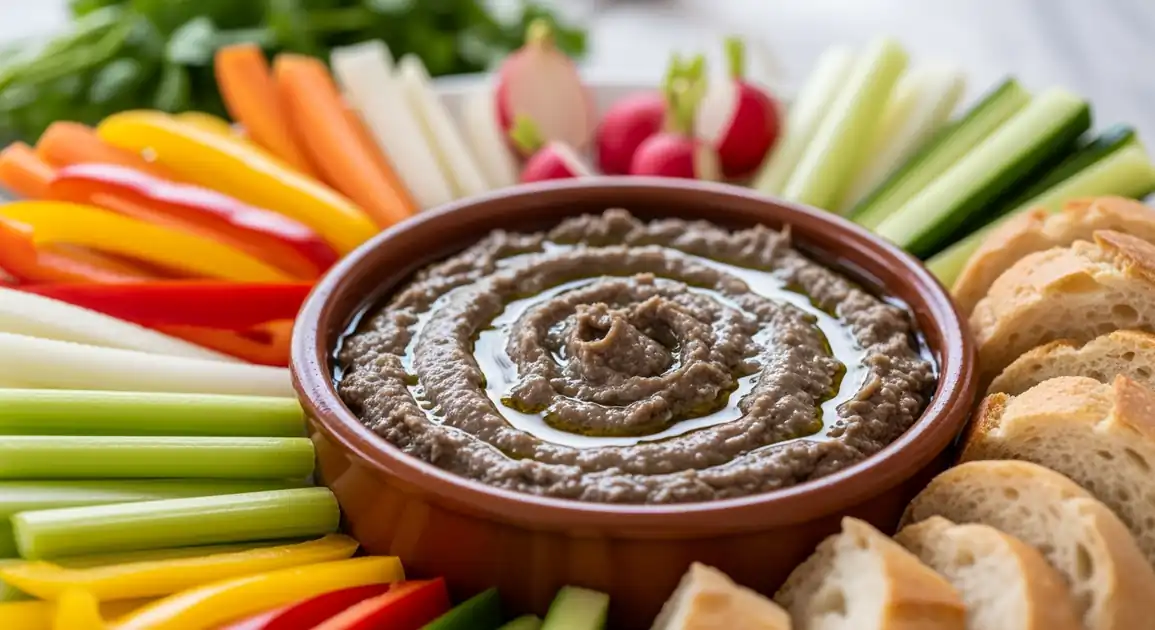Anchoïade
Anchoïade

Description
Anchoïade is intrinsically linked to the Provence region in the South of France. While you might find it occasionally in specialty stores or Provençal-themed restaurants elsewhere in France, its true home and highest prevalence is in Provence and along the French Riviera. It's a cornerstone of the local apéritif tradition.
Dietary Information
Serving information
Serving style
Served in a small bowl or ramekin, surrounded by fresh crudités and/or slices of bread/toast for dipping or spreading.
Quick facts
Restaurants: Lunch (12 PM - 2 PM), Dinner (7 PM - 10 PM). Markets: Typically mornings (8 AM - 1 PM). Traiteurs: Standard shop hours (e.g., 9 AM - 7 PM).
Safety Tips
What to Look For
-
Served with fresh, crisp crudités
Ensures the raw vegetable component is safe and appealing. Check for any signs of wilting or sliminess.
-
Dip stored properly (refrigerated if pre-made)
Prepared Anchoïade should be kept chilled to prevent bacterial growth, especially in warm weather.
-
Purchased from a reputable source
Choose established restaurants, trusted market vendors, or quality 'traiteurs' known for good hygiene standards.
-
Balanced flavor profile
While inherently salty, it shouldn't taste overwhelmingly of salt (which can sometimes mask lower quality anchovies) or have any off/rancid notes.
What to avoid
-
Wilted, slimy, or old-looking crudités
Indicates lack of freshness and potential bacterial contamination on the raw vegetables.
-
Anchoïade left sitting out at room temperature for extended periods
Increases the risk of bacterial growth, especially in warm environments like outdoor markets.
-
An overpowering 'fishy' or ammonia-like smell
Suggests the anchovies used might not have been of good quality or the dip is past its best.
-
Establishments with visibly poor hygiene standards
General cleanliness is a good indicator of overall food safety practices.
Price information
Price range
Budget tips
- Buying from a market vendor or 'traiteur' to enjoy with your own bread/veg can be more economical than ordering in a restaurant.
- Restaurant appetizer portions typically range from 6 to 15 EUR.
- Look for it as part of a larger 'planche apéro' (aperitif platter) for better value if sharing.
Value indicators
- Made with high-quality extra virgin olive oil.
- Good balance between anchovy, garlic, and oil – not excessively salty.
- Served with abundant, fresh, varied crudités.
- Rustic, appealing texture (not overly processed).
Where to Find This Dish
Provençal Markets
Outdoor markets throughout Provence often feature stalls selling local specialties including Anchoïade.
Marché Cours Saleya (Nice), Marché Place Richelme (Aix-en-Provence), Markets in Marseille, Arles, etc.
Market days (usually mornings)
Restaurants in Provence
Widely available in restaurants focusing on local/Mediterranean cuisine.
Restaurants in towns/cities across Provence-Alpes-Côte d'Azur
Lunch, Dinner (Apéritif)
Specialty Food Shops ('Traiteurs')
Delicatessens offering prepared foods often stock Anchoïade.
Found in most Provençal towns
Shop opening hours
Vendor Tips
- Look for vendors using local olive oil and high-quality anchovies.
- Taste if possible (some market vendors offer samples).
- Check the date if buying pre-packaged Anchoïade.
How to Order
Regional Variations
-
With Vinegar or Lemon Juice
(Avec Vinaigre ou Jus de Citron)
Some recipes add a small amount of vinegar (often red wine vinegar) or lemon juice to cut through the richness and add brightness.
-
Coarse vs. Smooth Texture
(Texture Grossière ou Lisse)
Traditional mortar-and-pestle preparation yields a coarser texture, while using a blender results in a smoother paste.
-
Warm Anchoïade
(Anchoïade Chaude)
A less common variation where the Anchoïade might be gently warmed and served with steamed or blanched vegetables instead of raw crudités.
-
With Capers
(Avec Câpres)
Occasionally, capers might be added, though this starts to blur the lines with Tapenade.
Cultural context
History
The roots of Anchoïade lie in the traditional cuisine of Provence, utilizing readily available preserved anchovies, a staple for coastal communities and fishermen. While sometimes linked anecdotally to ancient Roman fish sauces like garum, modern Anchoïade is distinct. It represents simple, flavorful peasant fare elevated to a beloved regional specialty, embodying the sun-drenched flavors of the Mediterranean and the importance of the apéritif ritual in Southern France.
Local significance
Embodies the flavors of Provence – sun, sea (via anchovies), and garlic. Central to the social ritual of the apéritif.
Eating customs
- Sharing the platter is common.
- Consumed before the main meal, stimulating the appetite.
- Paired with local rosé or white wine.